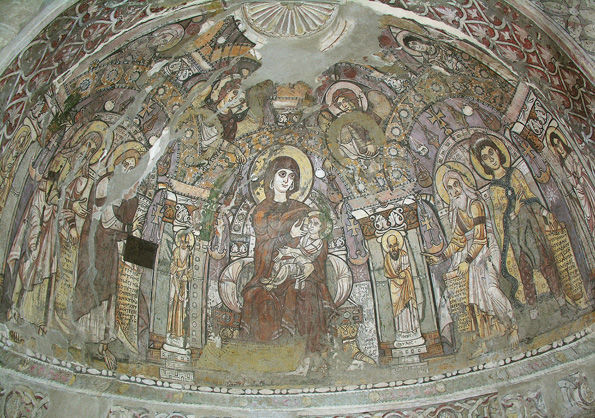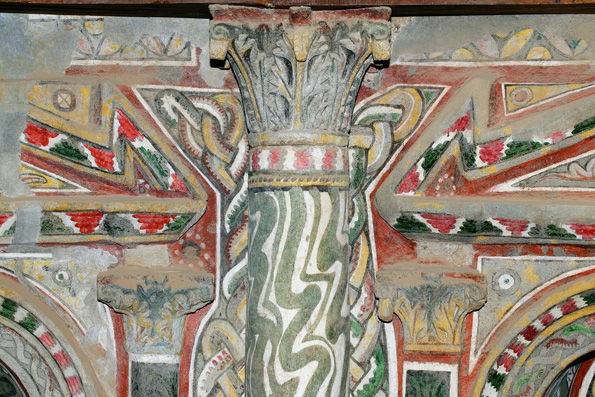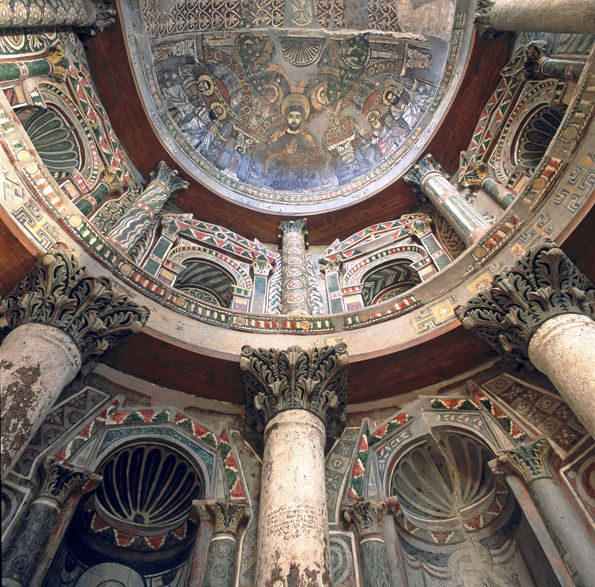Virgin Galaktrophousa (The Virgin nursing the Christ Child). Secco painting, ca. 7th century. North lobe of the sanctuary, Red Monastery Church, near Sohag, Egypt. Photograph: E. Bolman / © American Research Center in Egypt (ARCE)
Travelers from Cairo to Upper Egypt inevitably pass through the cities Bawit and Sohag. These cities, which are not on most itineraries, do not house many pharaonic antiquities (aside from the great Temple of Siti I, in Sohag), but they do boast fascinating late antique monuments.
Bawit lies along the Nile's west bank in middle Egypt, roughly forty miles north of Asyut. One mile inland in the desert stands the famous Monastery of Saint Apollo (Deir Abu Abullu), which was established by the monastery's namesake in the late fourth century. Saint Apollo, or Apa Apollo ("the equal of angels") in Coptic, was initially a merchant known for his generosity to the poor. He later pursued the ascetic life, fleeing to the desert to found one of its first monastic communities, which grew to include some five hundred monks engaged in agriculture and trade. Although the monastery was abandoned in the eleventh century, the ninety-nine acres of ruins that remain provide a glimpse into the lives of the monks who lived there. Pilgrims' graffiti and abundant polychrome paintings, some of which are in the Coptic Museum of Cairo, offer a panorama of the monastery's highly productive cultural life.
Detail of architectural polychromy. Secco and encaustic painting, ca. 6th–7th century. North Lobe of the sanctuary, Red Monastery Church, near Sohag, Egypt. Photograph: Arnaldo Vescovo / © American Research Center in Egypt (ARCE)
Between Bawit and Sohag to the south, Coptic Christian monasteries dot the desert along the Nile's west bank. Sohag itself is located seventy-two miles south of Asyut and approximately four miles southwest of the textile production center Akhmim. Nicknamed "the bride of the Nile" ('arous al-nil), Sohag and its surroundings contain many late antique Coptic Christian churches and monasteries, including most prominently the White (Deir al-Abyad) and Red monasteries (Deir al-Ahmar) dating roughly to the fourth century. The religious reformer Saint Shenoute contributed to developing both monasteries, though the Red Monastery has also been attributed to Saint Pishay of Akhmim. Both monasteries' exteriors recall the facade of an ancient Egyptian temple. On the inside, though, the Red Monastery's church displays an astounding combination of architectural patterns and contrasting bright colors, termed "the jeweled style."
Bawit and Sohag have maintained a strong Coptic Christian communal presence since antiquity.
View looking into the south lobe of the sanctuary, ca. 6th–7th century. Red Monastery Church, near Sohag, Egypt. Photograph: Arnaldo Vescovo / © American Research Center in Egypt (ARCE)


